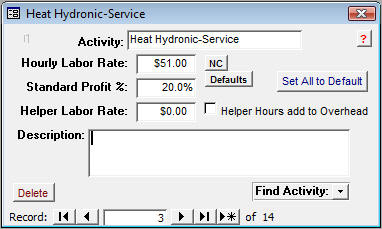“By including access to a safe drinking water supply and sanitation in these international goals, the world community proposes 97 million additional people annually will have access to drinking-water services and 138 million additional people access to sanitation services through 2015. Working within the spirit of these initiatives the World Health Organization and the World Plumbing Council developed the “Health Aspects of Plumbing” publication noting that sustainable health, especially for children, is not possible without access to safe drinking water and basic sanitation facilities”.
How Much is Your Business Worth?
 Whether you’re the owner, or an employee, chances are you don’t know how much the business is worth. And, chances are everyone thinks the business is worth more than it really is. This misunderstanding makes it difficult for the owner to to plan for retirement, and even harder to keep good employees.
Whether you’re the owner, or an employee, chances are you don’t know how much the business is worth. And, chances are everyone thinks the business is worth more than it really is. This misunderstanding makes it difficult for the owner to to plan for retirement, and even harder to keep good employees.
At this point you might be saying to yourself that you get how it affects the owner’s retirement plans, but how could not knowing the value of the business make it harder to keep good employees?
One of the biggest problems service companies have is keeping their top performing employees. After a few years of experience, many employees decide to leave to start their own businesses. They do this for many valid reasons, but the one that is most often sited is that they want to be recognized and rewarded for their contributions to the company. The obvious route to this goal is to become the boss, and make all that money that comes with owning the business.
For most, it’s not until they’ve been in business for themselves for a couple of years that they realize that being the boss is not as much fun as they thought. But, they can keep telling themselves that at least they’re building up value in the company that will pay off in the end.
So, just what don’t they know about selling their small business? What employee’s don’t see is the actual value of the business and the business selling process.
 Let’s take a look at a current on line listing for a 3 1/2 employee, 17 year old Plumbing company in Wisconsin. They had gross sales last year of $630,000 and Cash Flow (Annual Profit + Annual Payments to owners) of $100,000. The owner wants to retire but is willing to work part time for the new owner. The owner is also willing to finance the sale. The sale includes $140,000 in equipment and inventory. The asking price is $189,000.
Let’s take a look at a current on line listing for a 3 1/2 employee, 17 year old Plumbing company in Wisconsin. They had gross sales last year of $630,000 and Cash Flow (Annual Profit + Annual Payments to owners) of $100,000. The owner wants to retire but is willing to work part time for the new owner. The owner is also willing to finance the sale. The sale includes $140,000 in equipment and inventory. The asking price is $189,000.
So, after 17 years in business, the owner will sell his business for $49,000 after paying for the Equipment and inventory. Plus, he’ll lend you the money to make the purchase. This usually means that he is having a hard time making the sale at the asking price.
This is just one example that you can find on line. Some companies will sell for a much higher profit, but many will not sell at all. Some owners end up selling their inventory and client lists for pennies on the dollar. One current rule of thumb company value is a bit over two times cash flow depending on the market. So the seller can hope for about two years of profit plus salary as the value of the company.
This is the big payoff that many business owners count on for retirement? This is why top employees leave successful businesses to start their own companies?
These cold hard numbers are a warning to business owners and employees alike. If you are an employee thinking about striking out on your own, know that you probably won’t retire on the value of the company. Running your own business has its rewards and headaches, but building equity is a long shot.
 If you are a business owner, know that you need to pay yourself enough every year to save for retirement. You also need to be open with your employees about the business. Employees who know the general outlines of the your business’ financials may be less likely to strike out on their own. This can save you the cost of finding and training new, high quality employees.
If you are a business owner, know that you need to pay yourself enough every year to save for retirement. You also need to be open with your employees about the business. Employees who know the general outlines of the your business’ financials may be less likely to strike out on their own. This can save you the cost of finding and training new, high quality employees.
Crunching your numbers will pay off long before you try to sell the business and retire. You can build your retirement and your employee’s retirement into your every day numbers.
Kind Words for NSPG Flat Rate Price Book Software
Mike,
Just wanted to let you know how happy I have been with your price books. It has literally transformed my business. It has given me a way to charge a fair price on the job, and make a profit. Putting people into collections has become a thing of the past for us. We have gone from not showing a profit and owing all of our suppliers a lot of money to actually having more than enough money saved up to pay off all of our suppliers and to buy a box truck for cash.
Although I was a bit apprehensive about the purchase, my only regret is that I didn’t pull the trigger sooner. Besides the money that we are earning, your “coaching” has been an invaluable resource. I would be more than happy to speak to any of your prospective clients to let them know what a great business tool you provide.
Please feel free to post this email on your website or wherever as a client testimonial.
Dan Di Fabio
Reynolds Plumbing & Heating
Nexstar Peer Group Meeting
You’re invited to the Hargis Electric Peer Group Meeting
February 22-24 In Texas!
For the third year in a row, Nexstar has awarded Hargis the Select Service Award of Excellence – “Best of the Best.” They ranked #1 in their revenue category, benchmarked with fellow Nexstar member businesses.
Hargis delivers a superior level of business within Nexstar’s three pillars of success in the service industry: superior customer satisfaction, excellent working environment for employees, and profitability and financial well-being.
- Tap into successful strategies for generating revenue in a challenging economy
- Learn why Hargis partnered with their local power company to generate additional revenue and bring draw energy efficiency incentives
- Learn about Hargis’ recruitment process and why training requires new apprentices to pair with technicians on service calls
- Discover the Nexstar Service System – a key to Hargis’ success, building trust and confidence between the customer and the technician
 Nexstar Peer Group meetings set the standard and raise the bar for plumbing, HVAC and electrical home service business owners.
Nexstar Peer Group meetings set the standard and raise the bar for plumbing, HVAC and electrical home service business owners.
Business owners and upper managers are invited to join Nexstar members at Hargis Electric. Limited to two people per company.
Registration deadline is February 10, 2012.
Call 888.240.STAR
Bonus Depreciation – Save some Money This Year
 The Jobs Act of 2010 allows businesses to write-off up to $500,000 of qualified capital expenditures. Also, businesses that aren’t profitable this year can use 100% Bonus Depreciation on new equipment and carry-forward the loss to future hopefully profitable years. This deduction is known as Section 179.
The Jobs Act of 2010 allows businesses to write-off up to $500,000 of qualified capital expenditures. Also, businesses that aren’t profitable this year can use 100% Bonus Depreciation on new equipment and carry-forward the loss to future hopefully profitable years. This deduction is known as Section 179.
With Section 179 your business can deduct the full purchase price of qualifying equipment for the current tax year instead of depreciating it over time. The equipment must be purchased and put into use the current tax year. This can give you a substantial tax savings versus the old yearly depreciation method.
This should mean a substantial boost to your bottom line this year. To get the deduction for tax year 2011, you have to make the equipment purchase before then end of the year.
Qualifying Equipment includes: Equipment purchased for general business use like field equipment, computer hardware and software like Numbers Cruncher and National Standard Price Guide, and general office equipment.
You can get more information at Section 179.org and on the IRS site.
We’re All Power Hungry
 The extreme weather we’ve been having on the east cost reached a peak this autumn. Power outages, communications interruptions, and even washed out roads seem to be becoming commonplace. The October 31 snowfall here in New Jersey affected operations in two of our locations.
The extreme weather we’ve been having on the east cost reached a peak this autumn. Power outages, communications interruptions, and even washed out roads seem to be becoming commonplace. The October 31 snowfall here in New Jersey affected operations in two of our locations.
Our main sales and production facility lost power for almost a week, and limped along on generator power. Our programming/support site had power for the week, but had frequent Internet access interruptions. Our problems were minor compared to some of our neighbors, so we consider ourselves lucky.
During and after the outages, we kept wondering how the businesses who have gone 100% electronic for their business processes were fairing. How could they dispatch, quote, sell, bill when all of their current records are unavailable or just sporadically available.
Most of our users have printed price books, so their operations looked normal once they reached the customer’s location. In the office, battery backups and notebooks with backup copies of customer databases were indispensible. Stand alone desktop computers, the workhorse for most business operations were useless.
So, what have we learned from the past year of extreme weather?
Don’t put all your eggs in one basket. Electronic copies of documents and data make running your business easier than ever, but the old file cabinet filled with customer and supplier information still has a place in your business. For your electronic information, syncing between desktops, notebooks, and the cloud can really pay off in an emergency. We discussed free products that make this easy in our June Newsletter.
If you have a notebook that has all your up to date business information securely stored on it, you can at least take it to a location with power and Internet to keep your business running. You may even be able to use your computer to access your Internet based phone system from wherever you set up. Your customers won’t even notice the difference.
Redundant communication is another option. Internet based phone systems with all the features they bring are great for everyday use, but plain old telephone service (POTS) can be a life saver.
Printed price books still have a place beside the iPad and Android versions of your flat rate price books. You may not need to update your printed books as often as your electronic versions, but you will be glad you have a recent printed book when the lights go out, and you can’t charge your iPad.
Train your techs to be able to operate independently in the field. Keep them up to date in how to process credit card charges the old fashioned way. Make sure they know how to use the Universal Task Grid in your Flat Rate Price Books so they can quote a ny job without contacting the office.
ny job without contacting the office.
Between extreme weather and antiquated infrastructure, power and communication outages may be in your future. You need to be prepared for the worst, or you could be out of business for weeks or months as some in Connecticut and Vermont have experienced recently.
Interesting Links – October 2011
Quick Tip – Labor/Profit Rate Setup
Printing your books with prices that match your own business is a key benefit for NSPG Flat Rate users. As your business grows and changes, it is easy to customize your price books to match.
For example, say you want to add Hydronic Heat Service with its own labor and profit rates to your flat rate price books. Just open the Labor/Profit form, and enter your new Activity. You can even import the Hourly Labor Rate directly from your copy of Numbers Cruncher.
Once you have entered your new numbers for Hydronic Heat Service, you can quickly use them for all of the Tasks you choose. This will allow you to tailor your pricing to the type of job and even to the techs who do that type of work. You can be more price competitive and profitable on every job in your flat rate book.
“Work On Your Business”
 During our conversations with business owners and managers we constantly hear how difficult it is to find the time to “Work On the Business” after working 50 or 60 hours a week in the business. We all know that you build a better business by working on it, but actually doing it on a regular basis can seem like an insurmountable challenge.
During our conversations with business owners and managers we constantly hear how difficult it is to find the time to “Work On the Business” after working 50 or 60 hours a week in the business. We all know that you build a better business by working on it, but actually doing it on a regular basis can seem like an insurmountable challenge.
In addition to the lack of free time, we often don’t know how to get started working on the business. What should we deal with first, and even what does “Working On the Business” really mean. This uncertainty keeps many people from even getting started which makes the everyday business routine seem to be a never ending grind.
So, just what do we mean by “Working On your Business?”
Most of us can say what working on your business is not. It is not creating quotes, or ordering stock, or scheduling your techs. Those may be management duties, but they are working IN the business.
Working on your business requires a different perspective. It involves thinking about and planning for the future of the business. It’s improving your processes by figuring out how to make things work better, more reliably, and more simply. It’s the process of getting from where your business is today to your ideal business.
 To get started, you need to set aside some time every week to work on the business. Turn off the phone and the Internet, and go somewhere that you can be completely isolated from the daily noise. This simple first step is critical. You must commit to the time away from the business and the other distractions of your life so you can really think.
To get started, you need to set aside some time every week to work on the business. Turn off the phone and the Internet, and go somewhere that you can be completely isolated from the daily noise. This simple first step is critical. You must commit to the time away from the business and the other distractions of your life so you can really think.
First, consider the Big Picture of your business rather than the thousands of annoying details. The Big Picture involves visualizing the company you want to build, and then using this ideal business goal for inspiration to make the changes your business needs.
 As you create your big picture company and the detailed solutions you need to get there, be sure to write it all down. Documenting your ideas and goals will make them concrete, and improve your commitment to success.
As you create your big picture company and the detailed solutions you need to get there, be sure to write it all down. Documenting your ideas and goals will make them concrete, and improve your commitment to success.
Picture where you want your company to be in a year, five years, or longer. Create a picture complete with the details about how big the business will be, what trades and specialties you will expand into, how many employees you’ll have, what your sales and profits will be, what your role in the company will be.
This Big Picture will serve as your guide as you plan the changes you will make to your business.
This will lead you to the Details. What needs to be changed to accomplish your Big Picture goals. Identify the ladder of problems and changes that you will need to overcome to achieve your Big Picture goals.
Once you identify these detailed steps towards your ideal company, pick one to work on first. Analyze the problem so you can understand its root cause. Then, create a process to overcome the problem. This will be the first concrete change you implement based on your time spent “Working On the Business.” Establish exactly what success is, and set up a time line for reaching that success. Implement the changes and monitor your progress until the problem is eliminated.
 Success at implementing these small process changes will inspire you and your team to continue making the improvements you need to achieve your ideal company.
Success at implementing these small process changes will inspire you and your team to continue making the improvements you need to achieve your ideal company.
Like any big project, one of the hardest parts of working on your business is just getting started. Making a commitment of time and effort on a regular basis away from your work in the business is the key starting point. Take the time to establish your long term vision for your company. Just like any major project, break the journey from here to your ideal company into small steps, and implement them one by one.
Just don’t forget to take the time out away from the day to day business to evaluate the progress you are making, and to plot your future growth.



